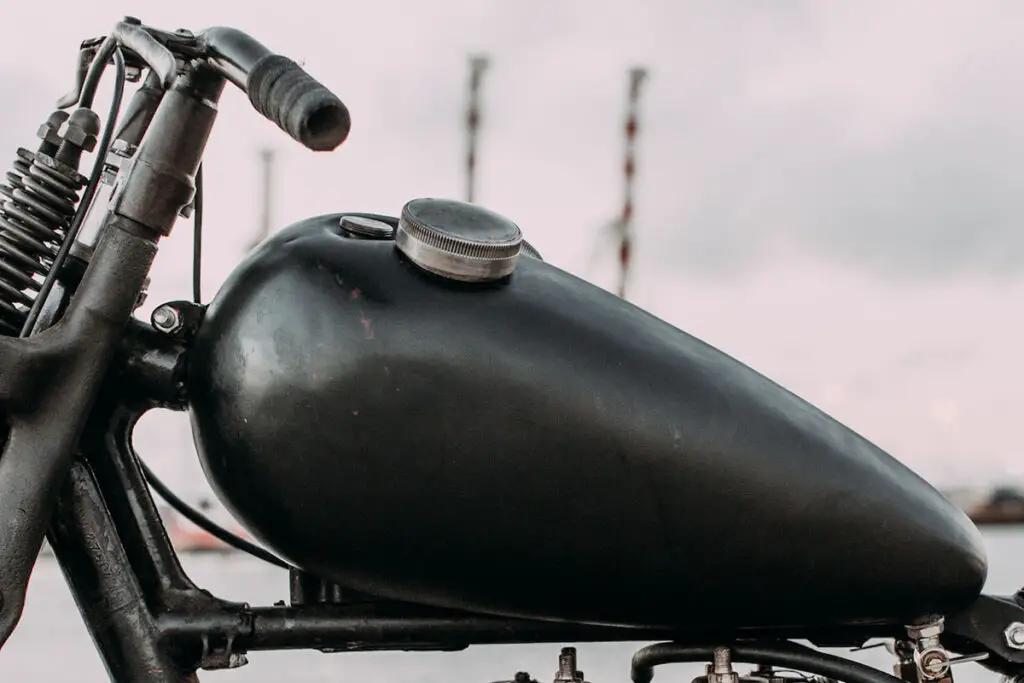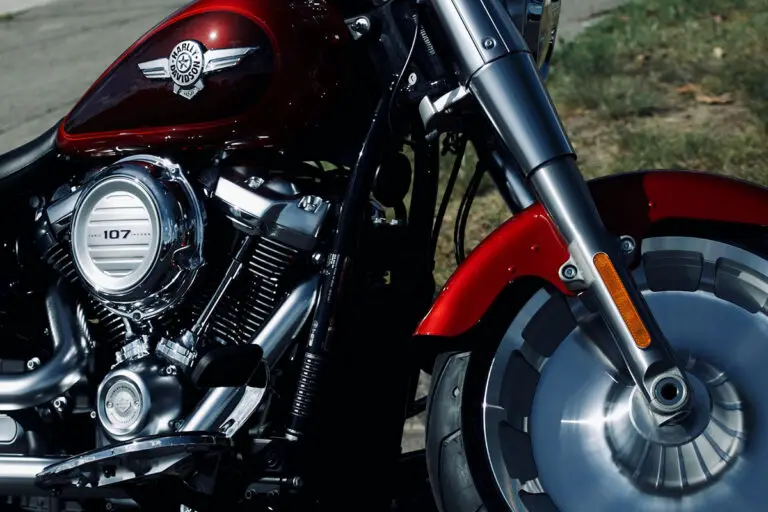How to Clean Rust out of a Motorcycle Gas Tank
Disclosure: We may get commissions for purchases made through links in this post.
The fuel tank is a vital component of a motorcycle’s fuel system and essentially stores and supplies fuel to the engine. It also incorporates various features to ensure efficient fuel usage and delivery. Given the significance of its role, it is important to keep it rust-free — which brings us to the gist of today’s article.
So, how do you clean rust out of a motorcycle gas tank? First, assess the damage caused by rust buildup and proceed with light cleaning if the tank is salvageable. Next, prep the tank and work on the rust with abrasives and cleaning solutions. Flush, rinse, and dry. And finally, apply a protective coating or fuel-soluble sealant.
Cleaning rust out of your motorcycle gas tank requires patience and a lot of precision. But no matter how laborious it may sound, it should not deter you from taking on the challenge. After all, you would want to utilize that prized fuel tank till its last drop. And the only way you can do that is to keep it from succumbing to corrosion.

How to Clean Rust out of a Gas Tank
To start, check out this article on the different types of fuel tanks.
For purposes of this guide, we will focus on cleaning rust out of an aluminum or steel motorcycle tank — since the other two types have greater corrosion resistance and are more unlikely to develop rust:
1. Drain the fuel tank
Completely drain the fuel tank to remove any remaining fuel or contaminants.
2. Assess the damage
Inspect the tank’s interior using a flashlight or borescope to quantify the damage caused by rust and assess whether it can be cleaned. If the tank exhibits severe rust or damage, has rotted through, or its design poses significant challenges for a thorough cleaning, it may be better to replace it.
3. Disconnect and detach
Disconnect any necessary fuel lines and sensors. Also, detach the tank from the motorcycle following OEM instructions if necessary.
4. Clean the exterior
Thoroughly clean the tank’s exterior using mild soap and warm water. Doing so helps remove dirt, grime, and loose rust particles.
For the inside, you may use a soft-bristle brush or sponge, gently scrubbing the interior of the tank and paying attention to areas with rust buildup. After which, rinse the tank thoroughly with clean water, ensuring all soap residue is flushed out.
5. Access the inside
Depending on the tank’s design, you may need to access the inside when preparing it for rust removal. (After all, your initial wash-and-rinse step would only cover a portion of the removal process — especially if the rust is stubborn). You can do this through the filler cap, fuel pump opening, or other designated access point.
Once you have chosen which orifice to use for rust removal, ensure all other openings are properly sealed. And depending on the design of your fuel tank, you may need one or more of the following — silicone plugs, rubber stoppers, threaded fittings, or vinyl vacuum caps. For modern-day two-wheelers, you may need to fabricate a sealer for the fuel pump plate.
6. Select a rust removal technique
They include commercial motorcycle gas tank rust removers, vinegar, or a combination of chemical treatment and mechanical cleaning (like using nuts and bolts or gravel to agitate the rust).
But before proceeding, refer to OEM guidelines or seek expert advice to confirm that your chosen method aligns with the tank’s material and current condition.
7. Follow the technique’s instructions
Depending on your technique of choice, follow the instructions provided with it. Some methods may involve filling the tank with a rust remover or a rust converter, allowing the latter to sit for a specific duration before flushing it out thoroughly with water. Others may require a wash-and-rinse approach. But instead of mild soap and warm water, use the commercial product.
In using acids to abate rust, it is ideal to start with something mild — like vinegar — and work your way up to something stronger if needed. The procedure may take longer but will ensure no damage to your fuel tank’s interior coating or protective layer.
However, if you ask experienced motorcycle owners, they find it preferable to stick to vinegar since stronger rust-removal substances may disintegrate petcocks and eat through the tank.
While at it, make sure you do this outside (preferably in a well-ventilated area). Especially if you are working with chemicals, you do not want those nasty fumes to build up indoors.
If using agitators, I strongly recommend testing them with the acid or chemical substance you will be using first. This way, you can ascertain two things: one, the chemical will have no adverse reaction to the nuts and bolts; and two, you do not risk inadvertently poisoning yourself while cleaning your motorcycle fuel tank.
8. Rinse the fuel tank
After applying the rust remover to your tank, dump that cleaning solution into an acid-proof bucket or basin. Then, thoroughly rinse the fuel tank with a garden hose. You would want to get as much acid and rust out of the tank, so I suggest sloshing the water inside as you rinse.
After which, use mild dish soap and hot water (not necessarily boiling) to neutralize any acid and remove any remaining rust remover or loose rust particles left inside the tank. Then ensure the tank is bone-dry before reinstallation. You may do this the old-fashioned way (air dry) or use a hair dryer or heat gun to speed things up.
9. Apply a sealant or protective coating
Once the tank is rid of stubborn rust and dried, apply a suitable sealant or protective coating to the interior of the tank. Confirm that the coating or treatment you will use is compatible with your steel or aluminum fuel tank and does not contain any harsh or corrosive ingredients that will damage its interior. For those new to this, fuel-soluble sealers are always a safe bet.
10. Let it dry
After application, let the protective coating dry completely to ensure it creates a durable and effective barrier against rust and other potential issues. This step is particularly necessary to prevent future corrosion.
Note that the drying time varies depending on the specific product used, so follow the instructions provided by the OEM of the protective coating or sealant.
11. Reinstall the fuel tank
After completing steps #1—10, you may reinstall the fuel tank on your motorcycle — again, following OEM instructions.
Best Products for Motorcycle Gas Tank Rust Removal
The best products depend on the severity of rust formation in the tank. Milder cases may only need vinegar, subtle agitators, and a protective coating. Conversely, worse cases may call for stronger acids and sealers.
That said, below are the best (not to mention the most common) products for getting rust out of your fuel tank. Note that they are often used in conjunction with another product (like abrasives) or process (for instance, electrolysis).
I have excluded specific brand recommendations for cleaning solutions, as they are typically made by professional technicians and are mainly suited for extensive rust removal scenarios.
Phosphoric Acid
Phosphoric acid is what you would call a rust converter and is known to be effective and works swiftly, etching the tank in as fast as 15 minutes. Usually, a 1:1 (up to 1:3) ratio of phosphoric acid and water gets the job done for most tanks with rust formation.
Additionally, it can be readily sourced from a local hardware store. You may even already have it at home!
Muriatic Acid
Conversely, muriatic acid is considered a rust remover stronger than phosphoric acid. Typically, a 1:10 (up to 1:20) dilution of muriatic acid in water is good for cleaning rusted tanks. Because it is more potent, it may take shorter than 15 minutes to get rid of corrosion. Again, the timing depends on how bad the rust buildup is.
Note that both substances have some downsides. They chew through solder quickly and are not advisable for motorcycle fuel tanks that have seen more than one repair or are older than your grandfather. They also damage fuel filler caps (especially muriatic acid).
If you are new to tinkering with motorcycle innards, you may want to go for milder acids while practicing.
Vinegar
A mild rust remover, vinegar contains acetic acid that dissolves rust and corrosion by reacting with the iron oxide and helping to break it down. This, in turn, makes it easier to remove rust from the tank’s surface. But apart from rust, it can also help remove other contaminants or buildup inside the tank — thanks to its inherent cleaning properties.
To remove mild rust from your tank, fill it with vinegar and let it soak overnight. Afterward, scrub the tank with a brush or sponge to remove loosened rust particles. For tougher cases, it may take a few more days of repeatedly soaking the interior in vinegar, scrubbing off rust, and rinsing.
Baking Soda
Also known as sodium bicarbonate, this alkaline substance is an effective, gentle abrasive cleaner. It removes light rust and acts as a scrubbing agent to clean the tank’s surface.
When using baking soda for rust removal, motorheads create a paste by mixing it with water (a 1:3 baking soda-water ratio is a good starting point) that they apply directly onto rusted areas of the motorcycle tank (whether inside or out). Then, they let the paste sit for a while — at least for a few hours or overnight — before scrubbing with a brush or sponge and rinsing it out thoroughly after.
Both vinegar and baking soda are non-toxic and generally safe to use, making them suitable options for cleaning a motorcycle fuel tank. However, stubborn rust is not within their scope, as the former usually requires more specialized rust removal methods or professional assistance.
Conclusion — How to Clean Rust out of a Motorcycle Gas Tank
Despite the how-tos I shared in this guide, the most effective approach to getting the rust out of a motorcycle gas tank is to prevent it in the first place. And it does not matter whether this is the first thing you do on a brand-new bike or if it is a remedial action on a beloved two-wheeler you have recently spent a grueling amount of time cleaning.
“How exactly do you prevent rust formation?” you may ask. It is keeping the tank full of fuel and using the bike! Regularly using a motorcycle with a full tank prevents corrosion by displacing air, minimizing moisture intake from ethanol-laced fuel, and promoting fuel circulation to remove condensation and residue. If you do this religiously, you may only need to oil your tank before disuse or storage to keep it from rusting!






